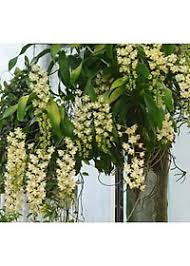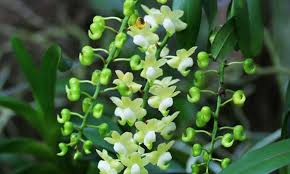
Dendrobium orchids, particularly the Đai Châu variety (*Dendrobium aggregatum*), are celebrated for their beautiful blooms and resilience. However, caring for these stunning orchids during the winter months can pose unique challenges due to changes in temperature, humidity, and light availability. This comprehensive guide provides detailed insights into the best practices for nurturing your Đai Châu orchids through the winter, ensuring they remain healthy and vibrant until spring.
## Table of Contents
1. **Understanding the Winter Needs of Dendrobium Orchids**
– 1.1 Overview of Dendrobium Orchids
– 1.2 Importance of Winter Care
2. **Optimal Environment for Winter Care**
– 2.1 Temperature Requirements
– 2.2 Humidity Levels
– 2.3 Light Conditions
3. **Watering Practices During Winter**
– 3.1 Frequency of Watering
– 3.2 Techniques for Watering
– 3.3 Signs of Overwatering and Underwatering
4. **Fertilizing Dendrobium Orchids in Winter**
– 4.1 Types of Fertilizers
– 4.2 Fertilization Schedule
– 4.3 Adjusting Nutrient Intake
5. **Pruning and Repotting Considerations**
– 5.1 When to Prune
– 5.2 How to Prune Effectively
– 5.3 Repotting in Winter
6. **Preventing Pests and Diseases**
– 6.1 Common Pests in Winter
– 6.2 Signs of Disease
– 6.3 Prevention and Treatment Strategies
7. **Encouraging Blooming After Winter**
– 7.1 Conditions for Triggering Blooms
– 7.2 Tips for Successful Flowering
8. **Conclusion**
—
## 1. Understanding the Winter Needs of Dendrobium Orchids
### 1.1 Overview of Dendrobium Orchids
Dendrobium orchids are among the most diverse and widely cultivated orchids in the world, with over 1,800 species. The Đai Châu variety is particularly popular for its stunning floral displays and adaptability. These orchids are native to various tropical and subtropical regions, thriving in warm, humid environments. However, their unique characteristics also allow them to withstand cooler temperatures, making them suitable for winter care with the right attention.
### 1.2 Importance of Winter Care
During the winter months, Dendrobium orchids enter a period of dormancy or reduced growth. Proper winter care is crucial to ensure that these plants remain healthy and vigorous. Inadequate care can lead to stress, poor health, and even death of the plant. Therefore, understanding the specific needs of Đai Châu orchids during winter is essential for any orchid enthusiast.
—
## 2. Optimal Environment for Winter Care
### 2.1 Temperature Requirements
Dendrobium orchids, including Đai Châu, prefer a temperature range of 65°F to 75°F (18°C to 24°C) during the day and slightly cooler temperatures at night, ideally around 55°F to 65°F (13°C to 18°C). During winter, it is important to protect these orchids from extreme cold, as temperatures below 50°F (10°C) can cause stress and damage.
### 2.2 Humidity Levels
Humidity is another critical factor for winter care. Dendrobium orchids thrive in humidity levels of 50% to 70%. During winter, indoor heating can lead to dry air, so it’s essential to maintain adequate humidity. Consider using a humidifier or placing trays of water near the orchids to increase humidity levels.
### 2.3 Light Conditions
Light is crucial for healthy growth and flowering. During winter, natural light levels can decrease significantly. Place your Đai Châu orchids in a location where they receive bright, indirect light. South or east-facing windows are ideal, but ensure that the plants are not exposed to direct sunlight, which can scorch their leaves.
—
## 3. Watering Practices During Winter
### 3.1 Frequency of Watering
Watering needs change during the winter months due to reduced evaporation rates and lower light levels. Generally, Dendrobium orchids require less frequent watering in winter. Water the orchids when the top inch of the potting medium feels dry to the touch. This may mean watering every 10 to 14 days, depending on environmental conditions.
### 3.2 Techniques for Watering
When watering, ensure that you water thoroughly, allowing excess water to drain out of the pot. Use room-temperature water to prevent shocking the roots. Avoid letting the orchids sit in standing water, as this can lead to root rot.
### 3.3 Signs of Overwatering and Underwatering
– **Overwatering**: Yellowing leaves, wilting, and root rot are common signs of overwatering. If you notice these symptoms, reduce your watering frequency and check the roots for health.
– **Underwatering**: Brown, shriveled leaves and dry potting medium indicate underwatering. If you see these signs, increase your watering frequency, ensuring thorough saturation.
—
## 4. Fertilizing Dendrobium Orchids in Winter
### 4.1 Types of Fertilizers
During the winter months, the nutritional needs of Dendrobium orchids change. It is best to use a balanced orchid fertilizer with equal parts nitrogen, phosphorus, and potassium (NPK). Fertilizers with lower concentrations are also suitable during this period.
### 4.2 Fertilization Schedule
Fertilization should be reduced during winter. A monthly application is usually sufficient. Begin fertilizing again when new growth appears in spring, transitioning to a bi-weekly schedule as the plant actively grows.
### 4.3 Adjusting Nutrient Intake
Pay attention to your orchid’s response to fertilization. If you notice excessive leaf growth but little to no blooming, consider adjusting your fertilizer to a higher phosphorus formulation to encourage flowering.
—
## 5. Pruning and Repotting Considerations
### 5.1 When to Prune
Pruning should ideally occur after the blooming period, typically in late winter or early spring. However, if you notice any dead or damaged growth, feel free to prune those sections at any time to maintain the plant’s health and appearance.
### 5.2 How to Prune Effectively
Use sterilized scissors or pruning shears to cut away dead or yellowing leaves and spent flower spikes. Make clean cuts to prevent introducing diseases. Avoid cutting live growth unless necessary, as this can stress the plant.
### 5.3 Repotting in Winter
While winter is not the ideal time for repotting Dendrobium orchids, it can be done if the plant is severely root-bound or if the potting medium has broken down. If you must repot, choose a well-draining orchid mix and ensure that you minimize root disturbance.
—
## 6. Preventing Pests and Diseases
### 6.1 Common Pests in Winter
Dendrobium orchids can be susceptible to pests such as aphids, mealybugs, and spider mites, particularly in dry winter conditions. Regularly inspect your plants for signs of infestation.
### 6.2 Signs of Disease
Look for symptoms such as yellowing leaves, wilting, and unusual spots or mold growth. Root rot is a common issue during winter, often caused by overwatering or poor drainage.
### 6.3 Prevention and Treatment Strategies
– **Prevention**: Maintain proper watering practices, humidity levels, and air circulation to reduce the risk of disease and pests. Clean the leaves with a damp cloth to remove dust and potential pests.
– **Treatment**: If you encounter pests, use insecticidal soap or neem oil as an organic treatment option. For root rot, remove the orchid from its pot, trim away the affected roots, and repot in fresh, dry medium.
—
## 7. Encouraging Blooming After Winter
### 7.1 Conditions for Triggering Blooms
To encourage blooming in Dendrobium orchids after winter, provide optimal conditions, including increased light exposure and a slight temperature drop at night to simulate natural seasonal changes.
### 7.2 Tips for Successful Flowering
– **Light**: Gradually increase light exposure as days lengthen. Consider using grow lights if natural light is insufficient.
– **Fertilizer**: Switch to a high-phosphorus fertilizer as new growth begins to encourage blooming.
– **Watering**: Adjust watering practices to match the needs of the actively growing plant, ensuring that the roots receive adequate moisture without becoming waterlogged.
—
## 8. Conclusion
Caring for Dendrobium orchids, particularly the Đai Châu variety, during the winter months requires a thoughtful approach that considers temperature, humidity, light, watering, and fertilization. By providing the right conditions and practicing attentive care, you can ensure your orchids remain healthy and vibrant through the cold months. With proper winter care, your Đai Châu orchids will be well-prepared to bloom beautifully in the spring, bringing joy and color to your home. Remember, the key to successful orchid cultivation lies in understanding their unique needs and responding accordingly. Happy growing!


